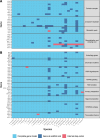Rethinking asexuality: the enigmatic case of functional sexual genes in Lepraria (Stereocaulaceae)
- PMID: 39455957
- PMCID: PMC11515122
- DOI: 10.1186/s12864-024-10898-8
Rethinking asexuality: the enigmatic case of functional sexual genes in Lepraria (Stereocaulaceae)
Abstract
Background: The ubiquity of sex across eukaryotes, given its high costs, strongly suggests it is evolutionarily advantageous. Asexual lineages can avoid, for example, the risks and energetic costs of recombination, but suffer short-term reductions in adaptive potential and long-term damage to genome integrity. Despite these costs, lichenized fungi have frequently evolved asexual reproduction, likely because it allows the retention of symbiotic algae across generations. The lichenized fungal genus Lepraria is thought to be exclusively asexual, while its sister genus Stereocaulon completes a sexual reproductive cycle. A comparison of sister sexual and asexual clades should shed light on the evolution of asexuality in lichens in general, as well as the apparent long-term maintenance of asexuality in Lepraria, specifically.
Results: In this study, we assembled and annotated representative long-read genomes from the putatively asexual Lepraria genus and its sexual sister genus Stereocaulon, and added short-read assemblies from an additional 22 individuals across both genera. Comparative genomic analyses revealed that both genera were heterothallic, with intact mating-type loci of both idiomorphs present across each genus. Additionally, we identified and assessed 29 genes involved in meiosis and mitosis and 45 genes that contribute to formation of fungal sexual reproductive structures (ascomata). All genes were present and appeared functional in nearly all Lepraria, and we failed to identify a general pattern of relaxation of selection on these genes across the Lepraria lineage. Together, these results suggest that Lepraria may be capable of sexual reproduction, including mate recognition, meiosis, and production of ascomata.
Conclusions: Despite apparent maintenance of machinery essential for fungal sex, over 200 years of careful observations by lichenologists have produced no evidence of canonical sexual reproduction in Lepraria. We suggest that Lepraria may have instead evolved a form of parasexual reproduction, perhaps by repurposing MAT and meiosis-specific genes. This may, in turn, allow these lichenized fungi to avoid long-term consequences of asexuality, while maintaining the benefit of an unbroken bond with their algal symbionts.
Keywords: Asexual; Comparative genomics; Lichenized fungi; Mating; Meiosis.
© 2024. The Author(s).
Conflict of interest statement
The authors declare no competing interests.
Figures


Similar articles
-
Dissociation and horizontal transmission of codispersing lichen symbionts in the genus Lepraria (Lecanorales: Stereocaulaceae).New Phytol. 2008;177(1):264-275. doi: 10.1111/j.1469-8137.2007.02241.x. Epub 2007 Oct 17. New Phytol. 2008. PMID: 17944828
-
A radical shift in the taxonomy of Lepraria s.l.: molecular and morphological studies shed new light on the evolution of asexuality and lichen growth form diversification.Mycologia. 2013 Jul-Aug;105(4):994-1018. doi: 10.3852/12-338. Epub 2013 May 26. Mycologia. 2013. PMID: 23709574
-
Obligate sexual reproduction of a homothallic fungus closely related to the Cryptococcus pathogenic species complex.Elife. 2022 Jun 17;11:e79114. doi: 10.7554/eLife.79114. Elife. 2022. PMID: 35713948 Free PMC article.
-
Sex and the Imperfect Fungi.Microbiol Spectr. 2017 Jun;5(3):10.1128/microbiolspec.funk-0043-2017. doi: 10.1128/microbiolspec.FUNK-0043-2017. Microbiol Spectr. 2017. PMID: 28597816 Free PMC article. Review.
-
Apomixis and the paradox of sex in plants.Ann Bot. 2024 Jun 7;134(1):1-18. doi: 10.1093/aob/mcae044. Ann Bot. 2024. PMID: 38497809 Free PMC article. Review.
References
-
- Weismann A. Essays upon Heredity and Kindred Biological problems. Clarendon; 1891.
-
- Muller HJ. Some genetic aspects of sex. Am Nat. 1932;66:118–38.
-
- Maynard Smith J. What use is sex? J Theor Biol. 1971;30:319–35. - PubMed
-
- Hörandl E, Bast J, Brandt A, Scheu S, Bleidorn C, Cordellier M, et al. Genome evolution of Asexual organisms and the Paradox of sex in eukaryotes. In: Pontarotti P, editor. Evolutionary Biology—A Transdisciplinary Approach. Cham: Springer International Publishing; 2020. pp. 133–67.
MeSH terms
Grants and funding
LinkOut - more resources
Full Text Sources

